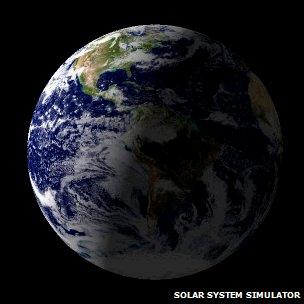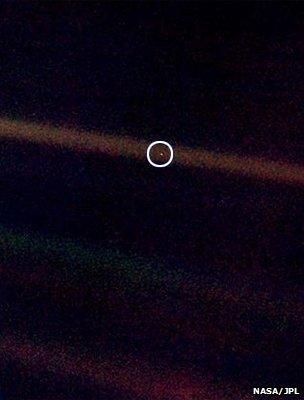Nasa’s Cassini probe to acquire distant Earth portrait
- Published

This favourite 2006 image of Saturn includes Earth as a speck just inside the G-ring at upper-left. In the coming picture, Earth will be lower-right. Dr Porco hopes it will look even better
Nasa's Cassini probe is going to try to take a special picture of Planet Earth.
The spacecraft will include our home world when it makes a giant mosaic of Saturn and its ring system.
In the Friday 19 July portrait, Earth will be almost a billion miles in the distance, external - a mere pixel in size.
Carolyn Porco, who leads Cassini's camera team, hopes the picture will be reminiscent of the famous "Pale Blue Dot, external" image captured by the Voyager-1 probe in 1990.
That was an image she helped produce. A major difference on this occasion is that people will know in advance that they are being photographed from the outer Solar System. They could wave, external, said the researcher from the Space Science Institute in Boulder, Colorado.
"People can celebrate it and join in. This will be like an interplanetary cosmic photo session," she told BBC News.
"People can enjoy the fact that we have a robot out there, a billion miles away, taking our picture. How cool is that?"
Cassini has caught sight of Planet Earth before as it has studied and photographed the ringed gas giant. But the set-up has never been ideal.
This time Dr Porco has searched through the upcoming mission plan for Cassini to find an occasion when she can properly frame the shot, using the most appropriate filters to capture Earth in natural colour.
Using the probe to look back towards the inner Solar System needs great care and must only be done when the Sun is eclipsed by Saturn. To do otherwise risks the full glare of our star falling on the probe's instruments and damaging their sensitive detectors.
In 2006, Cassini managed to do this in a mosaic that is routinely cited as the most popular picture ever taken by the satellite. It shows Saturn as a translucent orb surrounded by its rings, with Earth - a speck so small you could almost miss it - sitting in the upper-left of the frame. It is visible just inside the planet's faint G-ring.

This simulation shows the face Earth will present to Cassini
Dr Porco believes her Ciclops team, external can improve on the 2006 picture, especially if they use their high resolution camera to picture Earth during the 19 July opportunity.
No science is being interrupted for the purpose of getting the new mosaic. Researchers who will be working through the eclipse to gather infrared data on Saturn have agreed to accommodate Dr Porco in her quest to acquire what should be another spectacular vista.
Opportunities like this are few and far between, particularly given that Cassini is moving towards the end of its mission.
Nasa has determined that it will crash the probe into Saturn's atmosphere in 2017, but may pull the plug even earlier if its budget becomes severely constrained in the fiscal squeeze now afflicting US federal agencies.

Voyager pictured the Pale Blue Dot of Earth when it had travelled beyond Neptune
Although Cassini has been at the ringed planet for nine years now, scientists say there is still much to learn.
They plan to use the remaining time to make some manoeuvres that might have been regarded as too risky in the mission's early years.
This includes diving between Saturn and the inner C-ring. "That's kind of a wildly crazy thing to do, but it will give us very high resolution views of the rings," said Dr Porco. "And we really want to measure how massive the rings are. We're puzzled by that, and it's important because it plays into how long they've been around."
Cassini's images of Earth to be included in the mosaic - both wide angle and narrow angle - will be acquired between 21:27 and 21:42 GMT (17:27 and 17:42 EDT) on 19 July. During these times, North America and part of the Atlantic Ocean will be in sunlight. The illuminated parts of the Earth and the Moon will each be no more than one pixel across in the final image.
You can follow Dr Porco on Twitter, external as she builds up to 19 July. There is also an event page, external that provides more details. And watch Carolyn Porco reflect on the original Pale Blue Dot image.
Jonathan.Amos-INTERNET@bbc.co.uk and follow me on Twitter: @BBCAmos, external
- Published19 June 2013
- Published26 February 2013
- Published31 August 2011